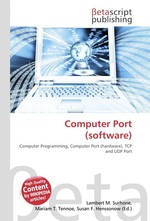Computer Port (software)
Lambert M. Surhone, Mariam T. Tennoe, Susan F. Henssonow
бумажная книга
High Quality Content by WIKIPEDIA articles! In computer programming, port has a wide range of meanings. A software port (usually just called a 'port') is a virtual/logical data connection that can be used by programs to exchange data directly, instead of going through a file or other temporary storage location. The most common of these are TCP and UDP ports, which are used to exchange data between computers on the Internet. In Flow-based programming, a 'port' is a (named) point of contact between a process and a connection. For Input or Output (I/O) operations, nearly all processor families use memory-mapped I/O—the same assembly instructions are used for both memory access and hardware I/O. However, Intel microprocessors use port-mapped I/O—they have a completely separate set of assembly instructions (IN, INS, OUT, and OUTS) that are used specifically for hardware I/O. These instructions figure out which hardware device to communicate with using the concept of an I/O port or machine port. These ports are numbered based on which hardware device they refer to. These hardware I/O ports are in a completely different address space from normal memory.
Данное издание не является оригинальным. Книга печатается по технологии принт-он-деманд после получения заказа.


